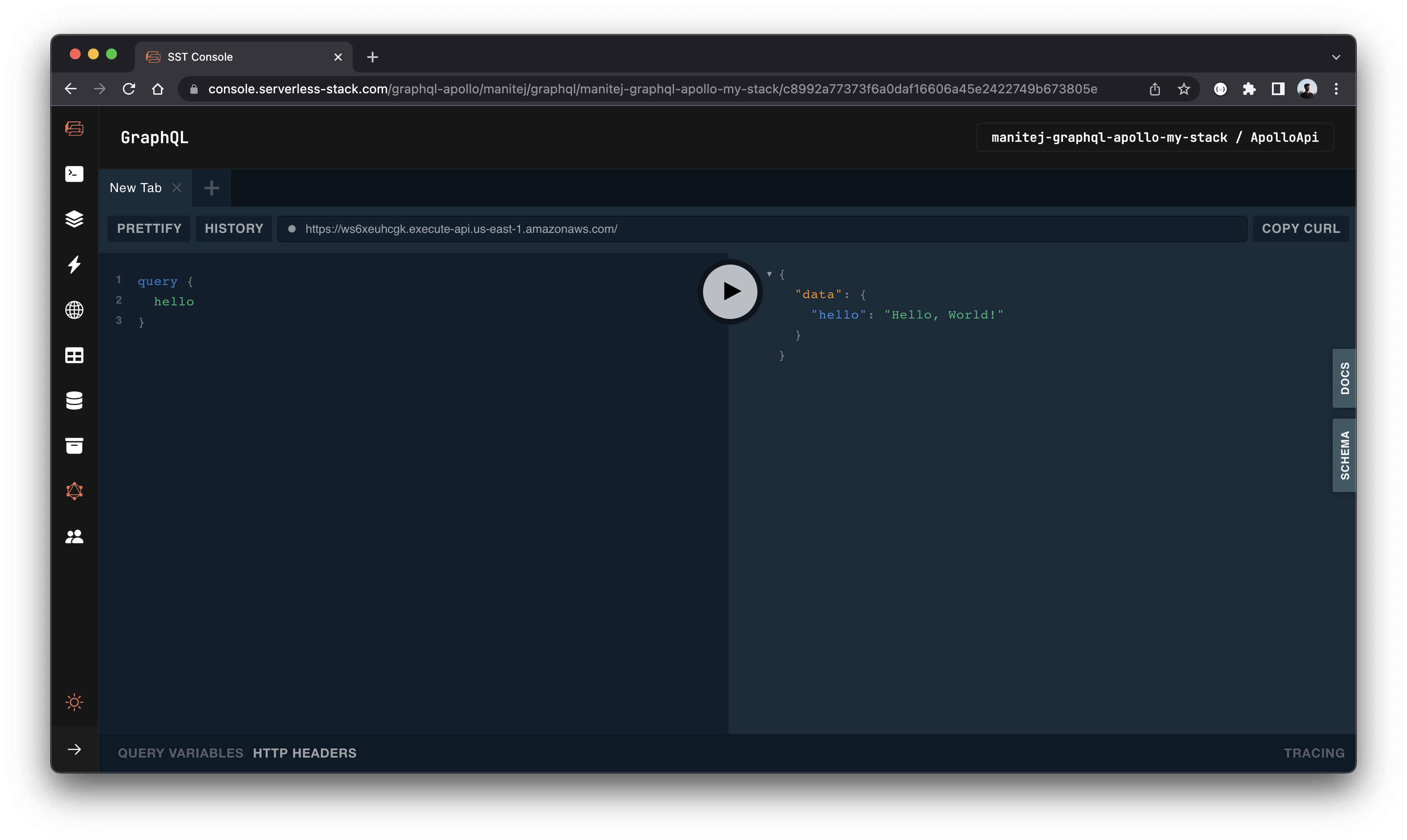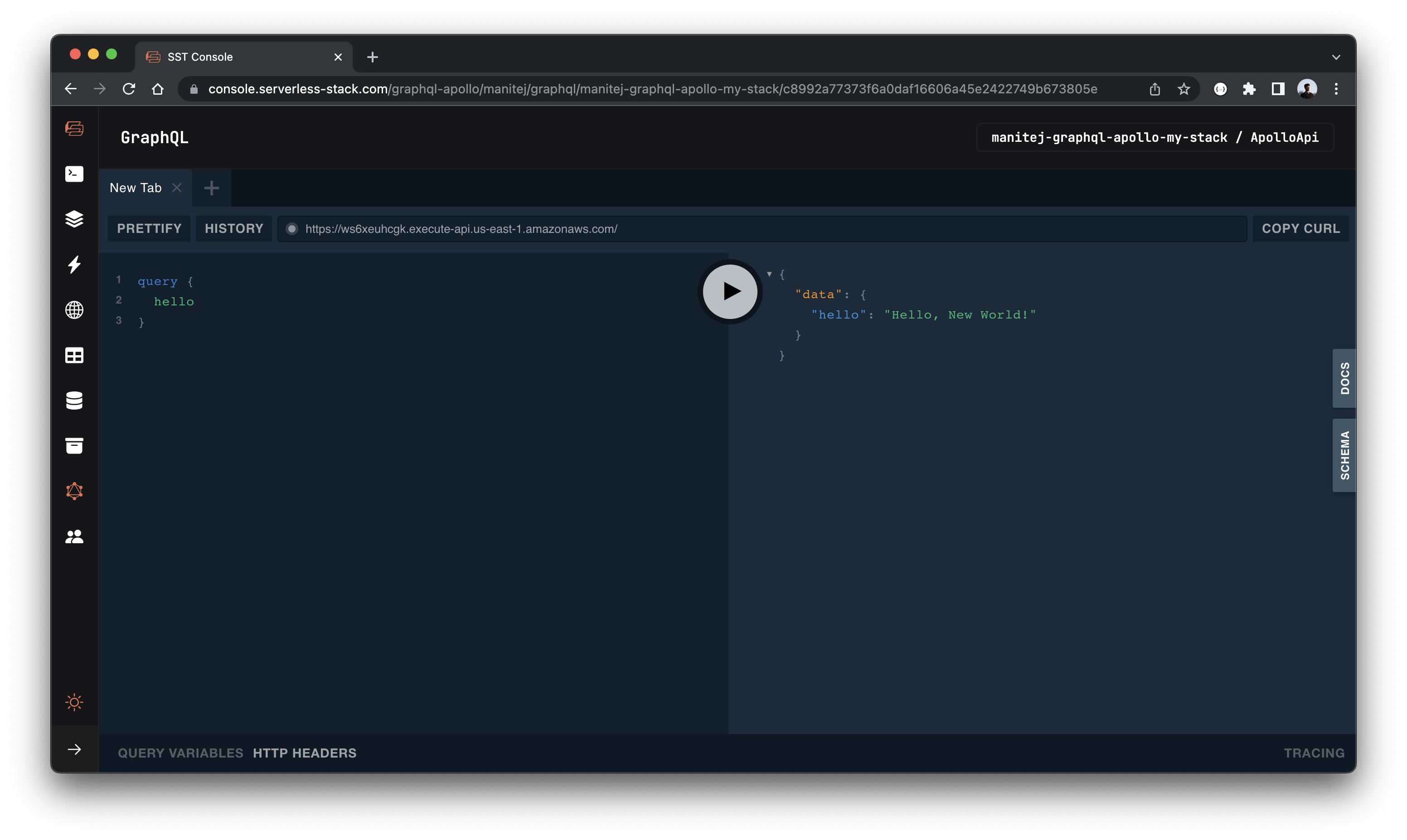How to create an Apollo GraphQL API with serverless
In this example we’ll look at how to create an Apollo GraphQL API on AWS using SST.
Requirements
- Node.js 16 or later
- We’ll be using TypeScript
- An AWS account with the AWS CLI configured locally
Create an SST app
 Let’s start by creating an SST app.
Let’s start by creating an SST app.
$ npx create-sst@latest --template=base/example graphql-apollo
$ cd graphql-apollo
$ npm install
By default, our app will be deployed to the us-east-1 AWS region. This can be changed in the sst.config.ts in your project root.
import { SSTConfig } from "sst";
export default {
config(_input) {
return {
name: "graphql-apollo",
region: "us-east-1",
};
},
} satisfies SSTConfig;
Project layout
An SST app is made up of two parts.
-
stacks/— App InfrastructureThe code that describes the infrastructure of your serverless app is placed in the
stacks/directory of your project. SST uses AWS CDK, to create the infrastructure. -
packages/functions/— App CodeThe code that’s run when your API is invoked is placed in the
packages/functions/directory of your project.
Setting up our infrastructure
Let’s start by setting up our GraphQL API.
 Replace the
Replace the stacks/ExampleStack.ts with the following.
import { GraphQLApi, StackContext } from "sst/constructs";
export function ExampleStack({ stack }: StackContext) {
// Create the GraphQL API
const api = new GraphQLApi(stack, "ApolloApi", {
server: {
handler: "packages/functions/src/lambda.handler",
bundle: {
format: "cjs",
},
},
});
// Show the API endpoint in output
stack.addOutputs({
ApiEndpoint: api.url,
});
}
We are creating an Apollo GraphQL API here using the GraphQLApi construct. Our Apollo Server is powered by the Lambda function in packages/functions/src/lambda.ts.
Adding function code
For this example, we are not using a database. We’ll look at that in detail in another example. So we’ll just be printing out a simple string.
 Let’s add a file that contains our notes in
Let’s add a file that contains our notes in packages/functions/src/lambda.ts.
import { gql, ApolloServer } from "apollo-server-lambda";
const typeDefs = gql`
type Query {
hello: String
}
`;
const resolvers = {
Query: {
hello: () => "Hello, World!",
},
};
const server = new ApolloServer({
typeDefs,
resolvers,
introspection: !!process.env.IS_LOCAL,
});
export const handler = server.createHandler();
Here we are creating an Apollo Server. We are also enabling introspection if we are running our Lambda function locally. SST sets the process.env.IS_LOCAL when run locally.
 Let’s install
Let’s install apollo-server-lambda in the packages/functions/ folder.
$ npm install apollo-server-lambda
We also need to quickly update our tsconfig.json to work with the Apollo Server package.
 Add the following to the
Add the following to the compilerOptions block in the tsconfig.json.
"esModuleInterop": true
Now let’s test our new Apollo GraphQL API.
Starting your dev environment
 SST features a Live Lambda Development environment that allows you to work on your serverless apps live.
SST features a Live Lambda Development environment that allows you to work on your serverless apps live.
$ npm run dev
The first time you run this command it’ll take a couple of minutes to deploy your app and a debug stack to power the Live Lambda Development environment.
===============
Deploying app
===============
Preparing your SST app
Transpiling source
Linting source
Deploying stacks
dev-graphql-apollo-ExampleStack: deploying...
✅ dev-graphql-apollo-ExampleStack
Stack dev-graphql-apollo-ExampleStack
Status: deployed
Outputs:
ApiEndpoint: https://keocx594ue.execute-api.us-east-1.amazonaws.com
The ApiEndpoint is the API we just created.
Let’s test our endpoint with the SST Console. The SST Console is a web based dashboard to manage your SST apps. Learn more about it in our docs.
Go to the GraphQL tab and you should see the GraphQL Playground in action.
Note, The GraphQL explorer lets you query GraphQL endpoints created with the GraphQLApi and AppSyncApi constructs in your app.
Now let’s run our query. Paste the following on the left and hit the run button.
query {
hello
}
 You should see
You should see Hello, World!.
Making changes
Let’s make a quick change to our API.
 In
In packages/functions/src/lambda.ts replace Hello, World! with Hello, New World!.
const resolvers = {
Query: {
hello: () => "Hello, New World!",
},
};
If you head back to the GraphQL playground in SST console and run the query again, you should see the change!

Deploying your API
Now that our API is tested, let’s deploy it to production. You’ll recall that we were using a dev environment, the one specified in our sst.config.ts. However, we are going to deploy it to a different environment. This ensures that the next time we are developing locally, it doesn’t break the API for our users.
 Run the following in your terminal.
Run the following in your terminal.
$ npx sst deploy --stage prod
Cleaning up
Finally, you can remove the resources created in this example using the following commands.
$ npx sst remove
$ npx sst remove --stage prod
Conclusion
And that’s it! You’ve got a brand new serverless Apollo GraphQL API. A local development environment, to test and make changes. And it’s deployed to production as well, so you can share it with your users. Check out the repo below for the code we used in this example. And leave a comment if you have any questions!
Example repo for reference
github.com/serverless-stack/sst/tree/master/examples/graphql-apolloFor help and discussion
Comments on this exampleMore Examples
APIs
-
REST API
Building a simple REST API.
-
WebSocket API
Building a simple WebSocket API.
-
Go REST API
Building a REST API with Golang.
-
Custom Domains
Using a custom domain in an API.
Web Apps
-
React.js
Full-stack React app with a serverless API.
-
Next.js
Full-stack Next.js app with DynamoDB.
-
Vue.js
Full-stack Vue.js app with a serverless API.
-
Svelte
Full-stack Svelte app with a serverless API.
-
Gatsby
Full-stack Gatsby app with a serverless API.
-
Angular
Full-stack Angular app with a serverless API.
Mobile Apps

GraphQL
-
AppSync
Building a serverless GraphQL API with AppSync.
Databases
-
DynamoDB
Using DynamoDB in a serverless API.
-
MongoDB Atlas
Using MongoDB Atlas in a serverless API.
-
PostgreSQL
Using PostgreSQL and Aurora in a serverless API.
-
CRUD DynamoDB
Building a CRUD API with DynamoDB.
-
PlanetScale
Using PlanetScale in a serverless API.
Authentication
Using SST Auth
-
Facebook Auth
Adding Facebook auth to a full-stack serverless app.
-
Google Auth
Adding Google auth to a full-stack serverless app.
Using Cognito Identity Pools
-
Cognito IAM
Authenticating with Cognito User Pool and Identity Pool.
-
Facebook Auth
Authenticating a serverless API with Facebook.
-
Twitter Auth
Authenticating a serverless API with Twitter.
-
Auth0 IAM
Authenticating a serverless API with Auth0.
Using Cognito User Pools
-
Cognito JWT
Adding JWT authentication with Cognito.
-
Auth0 JWT
Adding JWT authentication with Auth0.
-
Google Auth
Authenticating a full-stack serverless app with Google.
-
GitHub Auth
Authenticating a full-stack serverless app with GitHub.
-
Facebook Auth
Authenticating a full-stack serverless app with Facebook.
Async Tasks
-
Cron
A simple serverless Cron job.
-
Queues
A simple queue system with SQS.
-
Pub/Sub
A simple pub/sub system with SNS.
-
Resize Images
Automatically resize images uploaded to S3.
-
Kinesis data streams
A simple Kinesis Data Stream system.
-
EventBus
A simple EventBridge system with EventBus.
Editors
-
Debug With VS Code
Using VS Code to debug serverless apps.
-
Debug With WebStorm
Using WebStorm to debug serverless apps.
-
Debug With IntelliJ
Using IntelliJ IDEA to debug serverless apps.
Monitoring
Miscellaneous
-
Lambda Layers
Using the chrome-aws-lambda layer to take screenshots.
-
Middy Validator
Use Middy to validate API request and responses.


